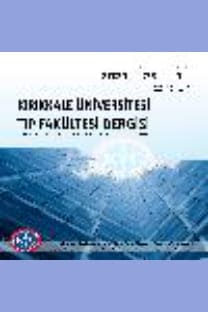İNMEMİŞ TESTİS NÜKSLERİNDE CERRAHİ DENEYİMLERİMİZ
inguinal herni, inmemiş testis, nüks, çocuk
Our Surgical Experiences in Recurrence Undescended Testis
inguinal hernia, undescended testis, recurrence, child,
___
- Dudley AG, Sweeney DD, Docimo SG. Orchiopexy after prior inguinal surgery: a distal approach. J Urol. 2011;185(6):2340-3.
- Palacio MM, Sferco A, García Fernanndez AE, Vilarrodona HO. Inguinal cordopexy: a simple and effective new technique for securing the testes in reoperative orchiopexy. J Pediatr Surg. 1999;34(3):424-5.
- Noseworthy J. Recurrent undescended testes. Semin Pediatr Surg. 2003;12(2):90-3.
- Lopes RI, Naoum NK, Chua ME, Canil T, Dos Santos J, Farhat WA. Outcome Analysis of Redo Orchiopexy: Scrotal vs Inguinal. J Urol. 2016;196(3):869-74.
- Pesce C, D'Agostino S, Costa L, Musi L, Manzi M. Reoperative orchiopexy: surgical aspects and functional outcome. Pediatr Surg Int. 2001;17(1):62-4.
- Sfoungaris D, Mouravas V, Petropoulos A, Filippopoulos A. Prentiss orchiopexy applied in younger age group. J Pediatr Urol. 2012;8(5):488-92.
- Sfoungaris D, Mouravas V. A combined preperitoneal and inguinal approach for redo orchiopexy. J Pediatr Urol. 2016;12(1):43.e1-6.
- Ziylan O, Oktar T, Korgali E, Nane I, Ander H. Failed orchiopexy. Urol Int. 2004;73(4):313-5.
- Cartwright PC, Snyder HM 3rd. Obstacles in reoperative orchiopexy--and a method to master them. Contemp Urol. 1993;5(8):56-64.
- Bianchi A, Squire BR. Transscrotal orchidopexy: orchidopexy revised. Pediatr Surg Int. 1989;4:189-92.
- Parsons JK, Ferrer F, Docimo SG. The low scrotal approach to the ectopic or ascended testicle: prevalence of a patent processus vaginalis. J Urol. 2003;169(5):1832-3.
- Tong Q, Zheng L, Tang S, Mao Y, Wang Y, Liu Y, et al. Laparoscopy-assisted orchiopexy for recurrent undescended testes in children. J Pediatr Surg. 2009;44(4):806-10.
- ISSN: 2148-9645
- Yayın Aralığı: Yılda 3 Sayı
- Başlangıç: 1999
- Yayıncı: KIRIKKALE ÜNİVERSİTESİ KÜTÜPHANE VE DOKÜMANTASYON BAŞKANLIĞI
FARKLI ÜNİVERSİTELERDEKİ DİŞ HEKİMLİĞİ FAKÜLTESİ ÖĞRENCİLERİNİN ORTODONTİ UZMANLIĞINA BAKIŞ AÇILARI
Türkan SEZEN ERHAMZA, Ebru İLHAN KOÇAK, Saadet ÇINARSOY CİĞERİM, Burçin AKAN,
PULMONER EMBOLİ HASTALARINDA ORTALAMA TROMBOSİT HACMİNİN DEĞERLENDİRİLMESİ
Ramazan GİDEN, Zeliha DEMİR GİDEN
İNMEMİŞ TESTİS NÜKSLERİNDE CERRAHİ DENEYİMLERİMİZ
Cem KAYA, Alparslan KAPISIZ, Ramazan KARABULUT, Zafer TÜRKYILMAZ, Kaan SÖNMEZ
Gebelikte Frontal QRS-T Açısının Değerlendirilmesi
Emre YILMAZ, Kıymet İclal AYAYDIN YILMAZ, Ercan AYDIN
Hastanede Çalışan Sağlık Personelinde COVID-19 Görülme Sıklığı ve Bulaş Yollarının Değerlendirilmesi
İzzettin TOKTAŞ, İbrahim VAKİT, Süleyman VARSAK, Özgür ERDEM, Gülşen YALÇIN, Celal ÖZCAN
Hayriye Mihrimah OZTURK, İrem EKMEKÇİ ERTEK
İSTANBUL’DA KAMU HASTANELERİNDE SAĞLIK HİZMET SÜREÇLERİNDE BEKLEME SÜRELERİNİN ANALİZİ
Büşra TEYİN, Pakize YIGIT, Olcay ÖZEN, İlker KÖSE, Sabahattin AYDIN
